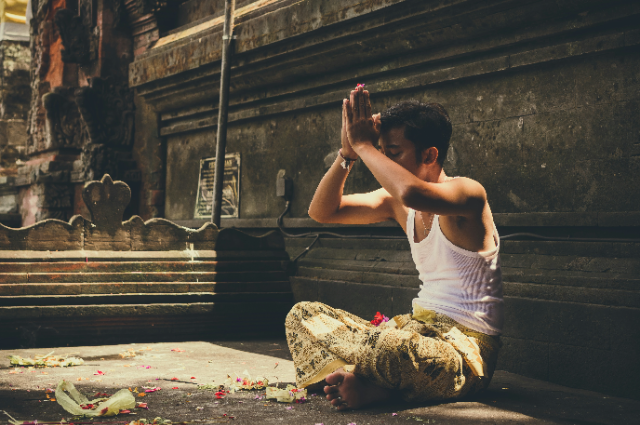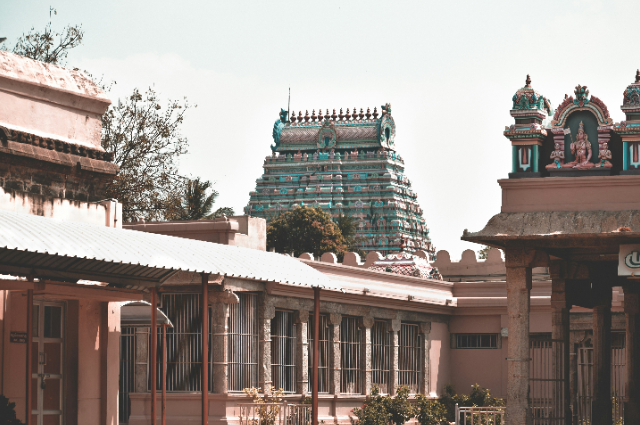
Photo by Artem Beliaikin on Unsplash
INTRODUCTION
"Any ritual is an opportunity for transformation." ~ Starhawk
India is a nation which is known across the world for its diversity, culture, festivals, traditions, and so many things. If, however, someone particularly talks about religions and traditions, one will have to do a PhD on it, and even then, the person will not be able to understand entirely the phenomena of existence and characteristics of all religions and their traditions. In India, various religions are present ranging from Hinduism, Buddhism, Jainism, Sikhism, Islam, Zoroastrianism and others. The world's oldest living religion in the world is found in India and that is none other than Hinduism. In India, precisely 79% of Hindus are here, who have been following the same rituals for the last 5000 years with almost the same intensity. Hinduism has various specialities which distinguish it from other religions of the world. Hinduism is not a religion but a way of life. It is a Dharma. What does it mean? It means a way of life. Dharam is about righteousness. It teaches how a person should live his or her life. It implies what to do and what not to do in life. Hinduism is primarily called as Sanātana Dharma.
Sanātana Dharma has its foundation in scientific spirituality. In the entire ancient Hindu literature, we can see that science and spirituality are integrated. It is mentioned in the 40th chapter of the Yajurveda, known as Eesaavaasya Upanishad, which uses scientific knowledge to solve problems in our lives and uses spiritual knowledge to attain immortality through a philosophical outlook. In Hinduism, rituals are strongly associated with religions, and most of the rituals have their reason for existence. Being an Indian and part of Indian society, an individual needs to be aware of the existence of these rituals and the causes behind them.
WHAT ARE CULTURE, TRADITIONS AND RITUALS?

Photo by Sanjeev Nagaraj on Unsplash
Culture means when a group of people follow the same ideology, speak the same language, wear almost the same sort of dress, consume the same kind of food items and follow the same traditions and rituals. On this once Anastasiya O. Russia pertinently observed, "Culture is something that unites people." It is a beautiful line, which displays the significance of culture and rituals.
In other words, culture is a concept that encompasses the social behaviour and norms found in human societies, as well as the knowledge, beliefs, arts, laws, customs, capabilities, and habits of the individuals in these groups. Culture is often originated from or attributed to a specific region or location. Furthermore, I would like to mention one point here that often people get confused with the usage of words like tradition and custom synonymous with culture. The distinction between the three of them is custom is the subset of tradition, and tradition is the subset of culture.
These are customs, traditions and rituals which determines that what will be the way of living of an individual, how he will dress up, how he will talk to people, how he will greet individuals, how he will just up, how he will speak, how he will consume the things from the society, how he will respond, how he will teach his offsprings about the world, how he will teach about the relationship between environment and humans and so many things. If culture is absent then the person is nothing but a savage.
SIGNIFICANCE OF SCIENTIFIC TEMPERAMENT
The term “scientific temperament” consists of two words; the former is associated with validated facts governed by certain principles of or relating to science. The second implies an attitude that affects how the individual behaves and feels. If we combine both terms, then it means that an individual imbibes the incidents which are going on around the world based on logic, facts and relevant points. In addition to this, developing a scientific temperament will equip students with the skills and habits necessary to make informed decisions and contribute positively to society. It is a scientific temperament which always keeps the people aware of the events carried out within the country and outside the country. It gives ability to an individual to allow his or her mind to bring rational thoughts in the mind.
If we talk about the Indian Constitution, in the 42nd Constitutional Amendment Act in 1976, Article 51 A(h) was added under the Fundamental Duties that states: [It shall be the duty of every citizen of India] To develop scientific temper, humanism and the spirit of inquiry and reform. The very first Prime Minister of India Pt. Nehru used to believe in the concept of having the element of scientific temperament in every citizen of India so that superstitiousness can be eliminated from the Indian society and by bringing the scientific approach, character building of the citizens can be done.
SCIENTIFIC LOGIC BEHIND THE INDIAN RITUALS

Photo by Sonika Agarwal on Unsplash
During the primordial era, when people were not educated, scholars and great saints thought about how to incorporate great things into the lives of the people. Then, they linked those great habits as rituals and brought them as part of the religion.
And at that time people respected the affairs of religion so much that they didn't raise questions and followed the acts, and thus those rituals came into being. Let's take a look following questions which often come to our mind and we consider how irrelevant that is and what their relevance is in the present world:
1. What is the usage of lighting up lamps outside the house and considering if Goddess Laxmi will arrive?
Logical reason: Since the primordial era, when there was no concept of electricity till the time when electricity penetrated the villages.
The only ray of light at night was a lamp. People used to light the lamp just outside the threshold of the underlying door. People would say that if you lit the lamp outside the door, Goddess Laxmi would arrive and sit in the house. People would say that because lamps were the only recourse to spread brightness at the door side and the door side was also the path for the venomous insects to come inside the house and act as a threat to life. So, lamps were lit to see those insects and keep away other animals from the house because animals are scared of fire or sparks. This was the actual reason. Therefore, even today it is often seen that people do it, even in the urban areas.
2. What is the cause of the presence of Tulsi, Peeple and Neem outside the house and worshipping them either?
Logical reason: In almost every house of a Hindu, plants and trees like Tulsi, Peeple and Neem are seen in the courtyard of every house, particularly in villages. People often associate the presence of these trees with the presence of godliness. They say that God himself resides in these trees, we must bow down before these trees and worship them. The scientific reason behind the regular plantation of these trees is the 24×7 production of oxygen and their remedial virtues. The dried leaves of Tulsi have been mixed with stored grains to repel insects. Vaishnavites are also known as "those who bear the tulsi around the neck". The tree of people has an immense capacity to provide oxygen day and night. With regard to Neem, it is said that Goddess Durga herself owns the tree. However, Neem has great qualities. It is used as an antibiotic on bruises; its fruits are used to take out the oil to light lamps to study and also to keep away mosquitoes from humans.
So, this was the reason behind providing so much reverence to these plants and trees in India.
3. Why do Indians observe fast on any day?
Logical Reason: In India, in Hinduism, the people observe fast on any day, in the name of any of the forms of God. Hinduism believes in monotheism through polytheism. It means that Hinduism believes that there is only one God, but it has various forms. It also believes that there are various names of God but the source of energy in one. Therefore, various religions could survive in India for hundreds and thousands of years. In Islam too, there is the concept of Roja in the month of Ramzan, in which fasting is done. In Hinduism, people are free to observe fast on any day in accordance to convince his/her deity. Indeed, the logical reason behind observing fast is to let the body stay free from the consumption of food or the indigestion process. If the body does not consume food for one day, then it starts detoxifying itself. If the stomach is empty, the body starts taking energy from the accumulated fat and this reduces obesity and other diseases. Fasting also allows the human body to transfer his/her energy for spiritual upliftment. Fasting also allows the body to establish control over its desires. Therefore, all these were the logical reasons behind the concept of observing fast.
4. Why do we ring the bell in a temple?
Logical reason: In every temple and house of a Hindu, a bell is found, whether it is small or big. If you move around the temple you'll hear the sound of a bell. What is the logic behind its usage?
Is it to wake up the Lord? But the Lord never sleeps. Is it to let the Lord know we have come?
He does not need to be told, as He is all-knowing. The Lord welcomes us at all times. Then why do we ring the bell?
The ringing of the bell produces what is regarded as an auspicious sound. It produces the sound Om, the universal name of the Lord.
There should be auspiciousness within and without to gain the vision of the Lord, who is all-auspiciousness.
5. Why do Indians say namaste instead of hello or good morning?
Logical Reason: Sanskrit namah + te = namaste. It means 'I bow down to you'. Namaha can also be interpreted as "na ma" (not mine). It has the spiritual significance of negating or reducing one’s ego in the presence of another.
The real meeting between people is the meeting of their minds. When we greet another, we do so with namaste, which means, "may our minds meet," indicated by the folded palms placed before the chest. The bowing down of the head is a gracious form of extending friendship in love and humility
The gesture is often accompanied by words like "Ram Ram,” "Jai Shri Krishna", "Namo Narayana", "Jai Siya Ram", "Om Shanti", etc., indicating the recognition of this divinity. When we know this significance, our greeting does not remain just a superficial gesture or word but paves the way for a deeper communion with another in an atmosphere of love and respect.
6. Why do we touch the feet of elders in India?
Logical reason: In India, elders are respected a lot and this can be seen in the form of touching their feet to take their blessings. However, the actual point is that this tradition of touching the feet had come into being to eradicate the ego of the person by making them touch the feet. And a kind of respect is always maintained between older and younger ones.
7. Why do Indians purchase gold and silver too much?
Logical reason: In the current world, there are so many precious metals like Platinum, Sapphire and Diamond. But Indians are seen to purchase primarily gold and silver. In most of the auspicious ceremonies, most people are seen with gold and silver only, and they consider that jewellery is used to decorate the human body only. If one asks them, they will say that it is considered auspicious and blessings of Goddess Laxmi. It is done by every woman who has precious metal in the house as a form of cash so that if any sort of mishap happens, then after selling that gold and silver, the family can come out of the economic problem.
8. Why shave your head if someone dies?
Logical reason: In Hinduism, whenever someone dies, there is a long procedure of traditions and rituals which are done after the crematorium. Amongst all of them, there is one tradition under which all the real relatives are supposed to remove their hairs from their heads and shave their beards and moustaches. The reason behind such a tradition is to remove ego because hair is often not touched by boys because they associate their ego and smartness with it. When, however, the hairs are removed, the ego is also removed. People are very much conscious about their hair and its style. As soon as hairs go away, a person starts looking inside the body rather than outside.
9. What is the point of wearing heavy tight bangles by married women?
Logical reason: In India, married women wear bangles. Is it a way of decorating the hands only? Is this a way of making sound? The actual reason behind it is to press the veins underneath and increase the blood flow in the reproductive organ. This leads to easy conception. This reduces the complexities which may come during the time of pregnancy.
10. Why do Indians eat the amalgamation of curd and sugar?
Logical reason: Whenever we go outside for the accomplishment of any major work, our mothers offer us a combination of curd and sugar. Along with that, they say that take it, everything will be really fine, and your work will be done effortlessly. The combination of curd and sugar supplies glucose to the body, which increases the energy level. It has a cooling and soothing effect on the body and mind.
11. Why do Indians offer water to the Sun?
Logical reason: It is often seen that after taking a bath, people offer water to the Sun. The Sun is highly respectable in Hinduism. As it gives life to plants and spreads brightness in the world. It is said that water is offered to get blessings of Sthe un or Surya Devta and appreciate his kind nature of giving life to plants, to whom we eat and fill our stomachs The actual reason is that when we pour water just after taking the bath in a wet cloth before the sun, it breaks down into a spectrum of seven colours. When these colours lie down on the body, health-related issues, such as improving the heart, increasing power, and causing any skin skin-related diseases, don't come into the life of the person.
CONCLUSION
The function of ritual, as I understand it, is to give form to human life, not in the way of a mere surface arrangement, but in depth. ~ Joseph Campbell
There are several other rituals or practices which are present in India and most of them have some logical reasons behind them. So, whenever we come across any ritual or practice then it is our responsibility to know about the actual reason behind those practices rather than raising questions on them. When I say this thing, it does not mean every practice is valid and relevant. There are many practices which do not have any point in existence; we need to raise curiosity and spirit t of enquiry in mind to know the actual reason.
. . .
REFERENCE:
- wikipedia.org
- thehindu.com
